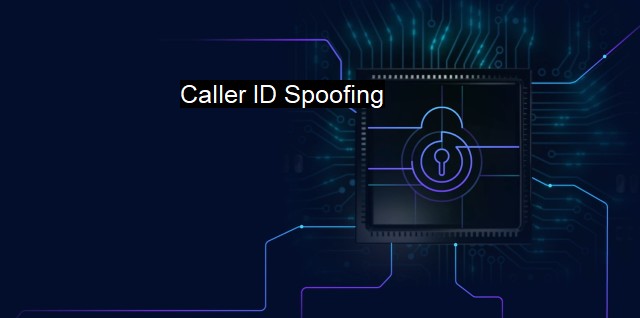What is Caller ID Spoofing?
Unmasking the Deceptive Practice of Caller ID Spoofing: Challenges, Implications, and Cybersecurity Solutions
Caller ID spoofing is a practice that manipulates the network to indicate that the call is coming from an area or number different from the actual originating station. It's a tactic frequently utilized in deceptive schemes designed to deceive call receivers, tricking them into giving away their valuable and sensitive information. In the widespread context of cybersecurity and antivirus measures, caller ID spoofing is gaining attention due to the growing sophistication of malicious attacks.Traditionally, mobile numbers and landline telephony worked based on genuine trust. When your phone rings and an unknown number is on the screen, you're reliant on ion the network providers accurately displaying the number that's causing your phone to ring. technology progressed, enabling unscrupulous entities to take advantage and exploit this trust via caller ID spoofing.
Caller ID spoofing operates by infiltrating Public Switched Telephone Networks (PSTN) or Voice-over-IP (VoIP) systems, the backbone of modern telephone communication globally. By using internet tools, deceivers could make a call appear to come from any phone number they choose. Consequently, the person receiving the call is likely to be misled into believing that the call originates from a legitimate and trusted source.
Attackers often employ caller ID spoofing as part of vishing scams or voice phishing, wherein the malicious entity impersonates institutions such as banks or tax agencies. Much like email phishing, vishing generates a fabricated sense of emergency or fear, pushing the victims into divulging confidential data like bank account information or social security numbers. The attackers then utilize this data for nefarious purposes, including stealing identities, draining accounts, or selling this harvested data on the dark web.
To counter these instances, cybersecurity measures play a crucial role. It is critical to equip and educate ourselves about these threats and maintain responsible practices when answering phone calls from unfamiliar numbers. Antivirus software companies now offer premium services to help their users identify potential caller ID spoofers. They use sophisticated algorithms and uphold a database of identified scam-numbers, providing alerts when call IDs match the ones in their databases. telecom carriers are working on introducing mechanisms such as STIR/SHAKEN protocol to validate callers across networks, significantly decreasing spoofed calls.
While this technology can lessen the danger, individuals bear the ultimate responsibility to maintain vigilance and healthy scepticism. Do not disclose personal information to unknown callers and verify their identities independently. If a caller alleges coming from a bank, for instance, hang up and redial the bank’s official customer service number from their official website.
Caller ID Spoofing is indeed a grave concern, comprising a salient part of cybersecurity issues within the larger digital safety landscape. Alarmingly, the increasingly convincing manipulative tactics used by criminals are facilitating successful spoofs. The cybersecurity industry, antivirus software companies, and telecom carriers are equally engaged in combating spoofing threats through both technical solutions and consumer education.
Nonetheless, cybersecurity safeguards alone are insufficient. Vigilance from every tech user plays an essential part in battling this contemporarily pervasive menace. We all must cultivate awareness and adopt defensive practices to navigate the ambiguous world of caller ID, where not everything we see on our screens should be necessarily believed. Therefore, the measures such as "When in doubt, hang up and don't disclose" should indeed be our guiding principle. Thereby taking control of and mitigating the effects of a less trustworthy networked world.

Caller ID Spoofing FAQs
What is caller ID spoofing?
Caller ID spoofing is a technique used by cybercriminals to disguise their identity and make it appear as if the call is coming from someone else. They can manipulate the caller ID information on your phone to display a different number, name, or even a picture of a person you might recognize.How does caller ID spoofing pose a threat to cybersecurity?
Caller ID spoofing poses a significant threat to cybersecurity since it is often used in phishing scams and other social engineering attacks. Cybercriminals can use spoofing to impersonate government agencies, banks, or other trusted institutions and convince victims to provide sensitive information like usernames, passwords, and credit card numbers.How can I protect myself from caller ID spoofing?
The best way to protect yourself from caller ID spoofing is to exercise caution when you receive calls from unknown numbers. Avoid providing personal information over the phone, especially if the caller is requesting it without any previous communication. You can also download caller ID and anti-spoofing apps on your phone, which can help detect and block spam calls.Is there any legal way to use caller ID spoofing?
Yes, there are a few legitimate uses for caller ID spoofing, such as businesses that display their toll-free number on outgoing calls or doctors who use a service to display their office number when calling patients. However, it is essential to obtain prior consent from the person or organization, and the spoofed information should be accurate and not misleading.| | A | | | B | | | C | | | D | | | E | | | F | | | G | | | H | | | I | | | J | | | K | | | L | | | M | |
| | N | | | O | | | P | | | Q | | | R | | | S | | | T | | | U | | | V | | | W | | | X | | | Y | | | Z | |
| | 1 | | | 2 | | | 3 | | | 4 | | | 7 | | | 8 | | |||||||